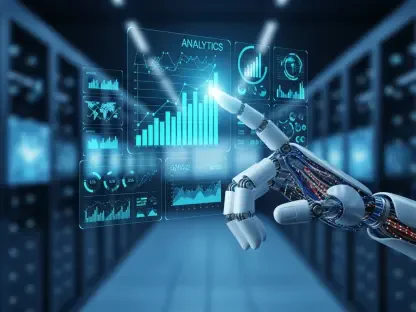In an era where artificial intelligence is no longer just a tool but a collaborator, consider the staggering reality that over 70% of repetitive business tasks could be automated by the end of this decade, according to recent industry estimates. This transformative potential is not merely about efficiency; it represents a fundamental shift in how humans and machines interact. At the forefront of this evolution is meta-agent AI, a paradigm that promises to orchestrate autonomous systems capable of mimicking human team dynamics. This report delves into the emergence of meta-agent AI, exploring its implications for industries, the challenges it faces, and its capacity to reshape collaboration between humans and technology.
Understanding Meta-Agent AI and Its Industry Context
Meta-agent AI represents a cutting-edge approach in artificial intelligence, designed to enhance system autonomy by overseeing and coordinating multiple AI agents in a cohesive network. Unlike traditional AI models that operate in isolation, meta-agent systems act as supervisors, ensuring seamless interaction and task delegation among subordinate agents. This innovation marks a significant leap toward creating intelligent ecosystems that can manage complex workflows with minimal human intervention, fundamentally altering operational frameworks.
The AI industry today is witnessing a pivotal transition from standalone tools to integrated multi-agent systems. Businesses are increasingly seeking solutions that not only automate tasks but also replicate collaborative human environments. This shift is driven by the need for scalability and adaptability in dynamic markets, where isolated chatbots or single-purpose algorithms fall short. Key players like RUNSTACK Inc., a Canadian AI-tech startup based in North York, Ontario, are pioneering this space with platforms focused on meta-agent technology, aiming to streamline automation across diverse sectors.
The significance of meta-agent AI lies in its potential to transform human-machine interactions by automating intricate processes while prioritizing user accessibility. With technological advancements such as Agent-to-Agent (A2A) communication and Model-Context Protocols (MCPs), these systems facilitate real-time collaboration and data sharing among agents. As AI infrastructure evolves, meta-agent technology could become the backbone of next-generation automation, enabling industries to achieve unprecedented efficiency and innovation in their operations.
Current Trends and Market Dynamics of Meta-Agent AI
Emerging Trends Shaping the Landscape
A dominant trend in the meta-agent AI domain is the drive toward self-building and self-healing systems within Software-as-a-Service (SaaS) frameworks. These systems are engineered to autonomously detect and resolve issues, reducing downtime and maintenance costs for businesses. This capability is particularly transformative for sectors reliant on continuous operations, such as logistics and customer service, where system reliability is paramount.
Another notable development is the emphasis on user-friendly interfaces that democratize access to AI technologies. By incorporating conversational platforms, companies are enabling non-technical users to deploy and manage AI agents without grappling with complex coding or technical setups. This trend aligns with the broader push to make advanced automation accessible to small and medium-sized enterprises, thereby expanding the market reach of meta-agent solutions.
Consumer and business demands are also evolving, with a growing need for intelligent automation in areas like project management, customer support, and sales operations. Multi-agent systems are increasingly viewed as virtual teams capable of planning, delegating, and executing tasks collaboratively. This mirrors human organizational structures, offering a glimpse into a future where AI not only supports but actively enhances operational efficiency through dynamic teamwork.
Market Performance and Growth Projections
Recent industry reports indicate that the market for multi-agent AI systems is experiencing rapid adoption, with a projected compound annual growth rate of over 25% from 2025 to 2030. This surge is fueled by the increasing integration of AI into everyday business processes, particularly in sectors seeking to optimize workflows. The market size, currently valued at several billion dollars, is expected to multiply as more organizations recognize the value of collaborative AI ecosystems.
Looking ahead, platforms like RUNSTACK’s upcoming beta release in early 2026 are poised to accelerate this growth. Such innovations promise to set benchmarks in integration speed and scalability, with tools like the Tooler engine demonstrating the ability to connect agents to external systems in minutes. These advancements signal a robust trajectory for meta-agent AI, positioning it as a cornerstone of automation strategies in the coming years.
A forward-looking perspective suggests that by the late 2020s, meta-agent AI could dominate key automation sectors, outpacing traditional single-agent solutions. Performance indicators, including system adaptability and user adoption rates, will likely serve as critical metrics for success. As businesses prioritize seamless scalability, the ability of meta-agent systems to handle expanding workloads will determine their long-term impact on the market.
Challenges in Implementing Meta-Agent AI Systems
Implementing meta-agent AI systems presents several technical hurdles, particularly in ensuring reliable A2A communication. The complexity of coordinating multiple agents in real time demands robust protocols to prevent errors or misalignments during task execution. Additionally, self-healing frameworks must maintain system stability under varying conditions, a challenge that requires continuous refinement and testing.
Market-driven obstacles also loom large, with user adoption posing a significant barrier, especially among non-technical audiences unfamiliar with AI deployment. Competition from established AI providers further complicates the landscape, as newer entrants must differentiate their offerings to capture market share. Addressing these challenges necessitates targeted education campaigns to build confidence in meta-agent technologies among diverse user groups.
Security and privacy concerns add another layer of complexity, particularly when integrating meta-agent systems with third-party tools and databases. The potential for data breaches or unauthorized access underscores the need for stringent safeguards. Strategies to mitigate these risks include rigorous beta testing phases to identify vulnerabilities and comprehensive user guides to ensure secure implementation across various environments.
Regulatory and Ethical Considerations for Meta-Agent AI
The regulatory landscape for AI infrastructure is becoming increasingly stringent, with data protection laws and interoperability standards shaping the deployment of meta-agent systems. Compliance with global frameworks is essential to prevent legal repercussions and ensure that these technologies operate within acceptable boundaries. Governments worldwide are prioritizing policies that safeguard user data while fostering innovation in AI applications.
Ethical dilemmas also warrant careful consideration, particularly the balance between automation and human employment. While meta-agent AI aims to enhance productivity, there is a risk of displacing certain job roles, necessitating transparent communication about its purpose. Additionally, ensuring clarity in AI decision-making processes is crucial to maintain trust among users and stakeholders interacting with these systems.
Companies like RUNSTACK have an opportunity to lead by example, aligning their platforms with industry standards to promote responsible innovation. By embedding ethical principles into their development processes, such firms can build credibility and foster public confidence. Proactive engagement with regulators and advocacy for fair practices will be instrumental in navigating the complex ethical terrain of meta-agent AI.
The Future of Human-Machine Collaboration with Meta-Agent AI
Meta-agent AI holds immense promise for the future of work by offloading repetitive tasks and amplifying human creativity and strategic thinking. As these systems evolve, they could enable professionals to focus on high-value activities, reshaping roles across industries. This shift may redefine workplace dynamics, fostering environments where technology and human ingenuity coexist harmoniously.
Emerging innovations, such as advanced conversational interfaces and self-learning integration engines, are set to further enhance meta-agent capabilities. These technologies will likely streamline interactions between users and AI systems, making collaboration more intuitive. Additionally, rapid progress in AI interoperability could disrupt existing paradigms, paving the way for seamless integration across diverse platforms and tools.
Global economic conditions and regulatory changes will also influence the adoption of meta-agent systems, with potential impacts on investment and scalability. Shifts in consumer preferences toward accessible technology could accelerate demand in sectors like healthcare and finance. As applications expand, meta-agent AI may unlock new growth areas, addressing unique challenges in specialized fields with tailored automation solutions.
Conclusion
Reflecting on the insights gathered, it is evident that meta-agent AI stands as a transformative force in redefining human-machine collaboration through its focus on autonomy and accessibility. The exploration of trends, challenges, and future prospects highlighted a technology brimming with potential to reshape industries. For businesses and investors, the actionable next step involves engaging early with innovations like RUNSTACK’s platform, leveraging beta phases to gain competitive advantages. Furthermore, fostering partnerships with regulatory bodies ensures compliance while advocating for ethical standards. As the landscape continues to evolve, staying ahead requires a commitment to adaptability, investing in user education, and prioritizing security to fully harness the capabilities of meta-agent AI in driving long-term efficiency and growth.









